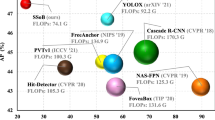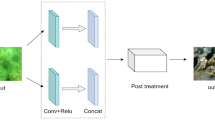Abstract
Object detection of continuous sonar image sequences has become an efficient way for underwater environment exploration. However, the task always suffers from the influence of th e complex underwater environment. In particular, the existing algorithms mainly focus on image-based detection and can not balance the detection speed and accuracy in continuous sonar image sequences. To solve the problem, this paper proposes a novel automatic detection algorithm based on deep learning for continuous sonar image sequences. Firstly, the convLSTM (convolution Long Short-Term Memory) is improved to fuse sonar features obtained from the cross-detection model, which are from three aspects: 1) The original convolution is replaced by depthwise separable convolution; 2) The original network input is divided into G groups and processed by group convolution; 3) A connection layer between the Bottleneck convolution layer and output is added to further capture feature information between frames. Then, to fully extract sonar features, a cross-detection network is established by fusing two different feature extraction networks MobileNetV3-Large and MobileNetV3-Small. Finally, we combine thecross-detection network with the improved convLSTM to establish the whole model, which can fully extract and utilize temporal information in continuous sonar image sequences. The experimental results show that the proposed model has effectively improved the detection speed in sonar image sequences at 150 FPS, simultaneously keeping an 85.8% mAP.









Similar content being viewed by others
Data availability
The availability of these data is limited, and they are used according to the license of the current study, so they are not publicly available.
References
Bochkovskiy A, Wang C-Y, Mark Liao H-Y (2020) Yolov4: Optimal speed and accuracy of object detection. arXiv preprint arXiv:2004.10934
Chollet F (2017) Xception: Deep learning with depthwise separable convolutions. In Proceedings of the IEEE conference on computer vision and pattern recognition, pp 1251–1258
Dura E, Zhang Y, Liao X, Dobeck GJ, Carin L (2005) Active learning for detection of mine-like objects in side-scan sonar imagery. IEEE J Ocean Eng 30(2):360–371
Fan Z, Xia W, Liu X, Li H (2021) Detection and segmentation of underwater objects from forward-looking sonar based on a modified mask rcnn. Signal, Image and Video Processing, pp 1–9
Feichtenhofer C, Pinz A, Zisserman A (2017) Detect to track and track to detect. In Proceedings of the IEEE International Conference on Computer Vision, pp 3038–3046
Guo J, Li Y, Lin W, Chen Y, Li J (2018) Network decoupling: From regular to depthwise separable convolutions. arXiv preprintar Xiv:1808.05517
Hochreiter S, Schmidhuber J (1997) Long short-term memory. Neural Comput 9(8):1735–1780
Howard AG, Zhu M, Chen B, Kalenichenko D, Wang W, Weyand T, Andreetto M, Adam H (2017) Mobilenets: Efficient convolutional neural networks for mobile vision applications. arXiv preprint arXiv:1704.04861
Howard A, Sandler M (2019) Searching for mobilenetv3. In Proceedings of the IEEE/CVF International Conference on Computer Vision, pp 1314–1324
Hurtós N, Palomeras N, Nagappa S, Salvi J (2013) Automatic detection of underwater chain links using a forward-looking sonar. In 2013 MTS/IEEE OCEANS-Bergen, pp 1–7
Hu J, Shen L, Sun G (2018) Squeeze-and-excitation networks. In Proceedings of the IEEE conference on computer vision and pattern recognition, pp 7132–7141
Hu K, Wang Z (2019) Graph sequence recurrent neural network for vision-based freezing of gait detection. IEEE Trans Image Process 29:1890–1901
Jiang Z, Liu Y, Yang C (2020) Learning where to focus for efficient video object detection. In European Conference on Computer Vision, pp 18–34
Kim J, Yu S-C (2016) Convolutional neural network-based real-time rov detection using forward-looking sonar image. In 2016 IEEE/OES Autonomous Underwater Vehicles (AUV), pp 396–400
Krizhevsky A, Sutskever I, Hinton GE (2012) Imagenet classification with deep convolutional neural networks. Adv Neural Inf Process Syst 25:1097–1105
Liu M, Zhu M (2018) Mobile video object detection with temporally-aware feature maps. In Proceedings of the IEEE conference on computer vision and pattern recognition, pp 5686–5695
Maki T, Horimoto H (2020) Tracking a sea turtle by an auv with a multibeam imaging sonar: Toward robotic observation of marine life. Int J Control Autom Syst 18(3):597–604
Ma Q, Jiang L, Yu W (2020) Training with noise adversarial network: A generalization method for object detection on sonar image. In Proceedings of the IEEE/CVF Winter Conference on Applications of Computer Vision, pp 729–738
McKay J, Gerg I, Monga V, Raj RG (2017) What’s mine is yours: Pretrained cnns for limited training sonar atr. In OCEANS 2017-Anchorage, pp 1–7
Myers V, Fawcett J (2010) A template matching procedure for automatic target recognition in synthetic aperture sonar imagery. IEEE Signal Process Lett 17(7):683–686
Qin R, Zhao X, Zhu W (2021) Multiple receptive field network (mrf-net) for autonomous underwater vehicle fishing net detection using forward-looking sonar images. Sensors 21(6):1933
Sung M, Kim J, Lee M (2020) Realistic sonar image simulation using deep learning for underwater object detection. Int J Control Autom Syst 18(3):523–534
Tian M, Chen H, Wang Q (2019) Detection and recognition of flower image based on ssd network in video stream. J Physics: Conf Ser 1237:032045
Valdenegro-Toro M (2016) Objectness scoring and detection proposals in forward-looking sonar images with convolutional neural networks. In IAPR workshop on artificial neural networks in pattern recognition, pp 209–219
Wang C-Y, Bochkovskiy A, Liao H-YM (2022) Yolov7: Trainable bag-of-freebies sets new state-of-the-art for real-time object detectors. arXiv preprintar Xiv:2207.02696
Wang Y-X, Girshick R, Hebert M, Hariharan B (2018) Low-shot learning from imaginary data. In Proceedings of the IEEE conference on computer vision and pattern recognition, pp 7278–7286
Wang Z, Zhang S, Huang W, Guo J, Zeng L (2022) Sonar image target detection based on adaptive global feature enhancement network. IEEE Sens J 22(2):1509–1530
Williams DP, Fakiris E (2014) Exploiting environmental information for improved underwater target classification in sonar imagery. IEEE Trans Geosci Remote Sens 52(10):6284–6297
Wu S, Liu Y, Li S, Zhang S (2022) Lsh-detr: object detection algorithm for marine benthic organisms based on improved detr. J Electron Imaging 31(6):063030
Zacchini L, Topini A, Franchi M, Secciani N, Manzari V, Bazzarello L, Stifani M, Ridolfi A (2022) Autonomous underwater environment perceiving and modeling: An experimental campaign with feelhippo auv for forward looking sonar-based automatic target recognition and data association. IEEE Journal of Oceanic Engineering, pp 1–20
Zhou T, Si J, Wang L, Xu C, Yu X (2022) Automatic detection of underwater small targets using forward-looking sonar images. IEEE Trans Geosci Remote Sens 60:1–12
Zhou W, Wang Z (2021) Research on autonomous detection method of underwater unmanned vehicle. In 2021 IEEE International Conference on Signal Processing, Communications and Computing (ICSPCC), pp 1–5
Zhu X, Xiong Y (2017) Deep feature flow for video recognition. In Proceedings of the IEEE conference on computer vision and pattern recognition, pp 2349–2358
Acknowledgements
This work has been supported by the National Key R&D Program of China (2022YFB4703405) and the Fundamental Research Fund for the Central Universities (B220202020).
Author information
Authors and Affiliations
Corresponding author
Ethics declarations
Conflict of interest
The authors declare that they have no conflict of interest.
Additional information
Publisher's note
Springer Nature remains neutral with regard to jurisdictional claims in published maps and institutional affiliations.
Rights and permissions
Springer Nature or its licensor (e.g. a society or other partner) holds exclusive rights to this article under a publishing agreement with the author(s) or other rightsholder(s); author self-archiving of the accepted manuscript version of this article is solely governed by the terms of such publishing agreement and applicable law.
About this article
Cite this article
Shi, P., Sun, H., Fan, X. et al. An effective automatic object detection algorithm for continuous sonar image sequences. Multimed Tools Appl 83, 10233–10246 (2024). https://doi.org/10.1007/s11042-023-15837-5
Received:
Revised:
Accepted:
Published:
Issue Date:
DOI: https://doi.org/10.1007/s11042-023-15837-5




